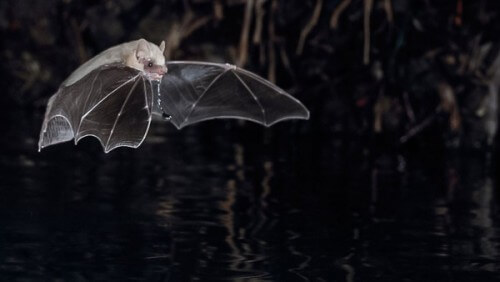For bats, too many echoes and echoes equate to blurred vision. This is because these nocturnal creatures navigate by reflecting ultrasonic sound waves from their surroundings, a technique known as echolocation. In dense areas, a situation may arise where the voices echo and create a noisy background that obscures the bats' sonic vision.

Adaptation: Gilat Simon
Published on 8.5.15 in the journal Science
what is it about? About bats that navigate using pulses of sound waves, that deal with dense areas and prevent unnecessary background noise by focusing the pulse of sound waves. And how do you do it? It is the key of the mouth that determines. Wide opening - focused and narrow beam. The problem is a wider beam.
For bats, too many echoes and echoes equate to blurred vision. This is because these nocturnal creatures navigate by reflecting ultrasonic sound waves from their surroundings, a technique known as echolocation. In dense areas, a situation may arise where the voices echo and create a noisy background that obscures the bats' sonic vision.
Now, a new study by researchers at Tel Aviv University published in the scientific journal PNAS, reveals one way in which bats overcome this limitation. The researchers found that the bats change the width of the navigation pulse while flying by adjusting the size of the mouth opening. The researchers used an array of cameras, flashlights and ultrasonic recording devices to photograph and record the bats as they swooped down to sip from a pool of water in the desert in Israel.
As the bats descended toward the edge of the enclosed pool of water, they opened their mouths wider to better focus on the sound beats. When the bats left, they narrowed their mouths, and thus emitted an ultra-sonic beam four times wider than the one sent on the downward journey.
These counter-intuitive effects were due to diffraction, which causes sound waves traveling through a smaller hole to spread out further. Diffraction is a physical phenomenon known as diffraction and occurs when a wave hits a bone, causing a distortion in the wave front. The result is the creation of a new wave, the intensity of which varies in space in a complex pattern, caused by the interference between different parts of the wave, each of which travels a different distance on its way from the source to the viewer, and therefore, its occurrence after a given time is different. Diffraction can be seen as an interference phenomenon involving a large number of wave fronts, or alternatively - a large number of sources. The bypass determines the upper performance limit that a wave routing system can reach.
The researchers repeated the experiment with bats in captivity and found the same phenomena, thus the captive bats were used as a control that ruled out the possibility that it was a phenomenon related to the thirst that attacked the free bats. The researchers report that these changes in the width of the mouth opening allow the bats to focus (zoom-in) when viewing a wide area and thus potentially reduce the amount of distracting echoes in a small and crowded space.
The researchers who participated in the study: Pavel Konicki, Jens Riedel, Eran Amichi, Arian Bonman Ofri Eitan from the Department of Zoology at the Faculty of Life Sciences at Tel Aviv University
Antony Weiss from the School of Electrical Engineering at the Faculty of Engineering and Yossi Yuval from the Department of Zoology and the Segol School of Neuroscience at Uni Tel Aviv.
for the article in PNAS
For information on the Science website

One response
Good Morning .
Please proofread.
List thousands - should be bats.
The surname of the researcher Eran is Amichai and not Amichi.